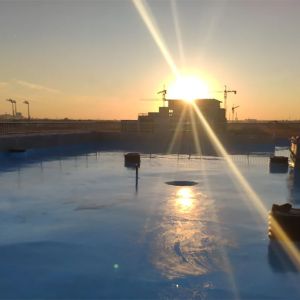| Sign In | Join Free | My himfr.com |
|
| Sign In | Join Free | My himfr.com |
|
| Ask Lasest Price | |
| Brand Name : | Zhuhai Feiyang |
| Model Number : | Abrasion Resistance Testing of Polyaspartic |
| Certification : | ISO 9001-2015, ISO 14001-2015 |
| Payment Terms : | L/C, T/T |
| Supply Ability : | More than 20000 tons per year |
| Delivery Time : | 7 days after orders comfirmed |
Abrasion resistance is one of the core advantages of polyaspartic,
making it particularly suitable for high-frequency wear scenarios
such as industrial flooring, ore chutes, and logistics warehouses.
Standard: ASTM D4060 (U.S.)
Principle: A specified abrasive wheel (e.g., CS-10 rubber wheel, 1
kg load) is rotated against the specimen (500–5000 cycles), and the
mass loss (mg) or volume loss (mm³) is measured.
Typical polyaspartic value:

Comparison: Epoxy flooring typically shows 80–150 mg loss, PVC
flooring about 50–80 mg loss.

Standard: ASTM D968 (U.S.), ISO 5470 (International)
Principle: Quartz sand of specified particle size (e.g., 0.5–0.7
mm) flows through a guide tube to impact the coating surface at a
45° angle. The volume of sand required to wear through 1 μm of
coating thickness (L/μm) is measured.
Polyaspartic performance: ≥40 L/μm (epoxy resin approx. 15–25 L/μm)
Note: Higher values indicate greater abrasion resistance.
Standard: DIN 53754 (Germany, simulating forklift traffic)
Method: A 50 kg steel wheel repeatedly rolls across the specimen
surface (1000 cycles), and the depth of wear (mm) is measured.
Polyaspartic result: <0.02 mm (ordinary concrete >0.3 mm).

Procedure:
1.Impact the specimen with a 1 kg steel ball dropped from a height
of 1 m (GB/T 1732) to create an indentation.
2.Perform Taber abrasion (500 cycles) on the indentation area.
3.Observe whether the edges of the indentation show flaking or wear
propagation.
Polyaspartic advantage: Due to high elastic recovery, indentation
rebound is >80%, and no crack propagation occurs in the worn
area.
Method: Preheat the specimen to the set temperature, then conduct
Taber abrasion (1 kg load, 1000 cycles).
Data comparison:

Simulation: After soaking in water for 24 h, conduct Taber
abrasion; apply 5% H₂SO₄ or engine oil to the surface and perform
DIN rolling tests.
Result: Wet abrasion loss increases by <10%, with no performance
degradation in acid/oil environments.
Standard: ASTM E303 (Pendulum Skid Resistance Tester)
Purpose: Ensures a balance between abrasion resistance and slip
resistance (coefficient ≥0.6 is considered safe).
Polyaspartic data: Dry: 0.75–0.85; Wet: 0.65–0.75 (with anti-slip
aggregate >0.8).

Case indicators:

High crosslink density: Three-dimensional network structure
disperses stress, reducing cutting damage from abrasive particles.
Hard-segment/soft-segment microphase separation: Hard segments
(urea bonds) provide rigidity, soft segments (polyether/ester)
absorb impact energy.
Elastic deformation recovery: Polymer chains rebound after
compression, preventing permanent deformation (contrast with the
brittle fracture of epoxy resin).
Microscopic wear surface morphology: SEM images show that
polyaspartic wear surfaces are smooth with no flake detachment
(epoxy shows a cracked pattern).
Taber abrasion (ASTM D4060)
Falling sand abrasion (ASTM D968)
Additional wet/high-temperature tests
SGS (comprehensive abrasion and slip resistance reports)
Abrasion resistance reference table (for key application
scenarios):

1.Severe wear scenarios (ore chutes, unloading zones): Taber
abrasion ≤30 mg + Falling sand ≥35 L/μm
2.Temperature resistance requirement: For environments >60°C,
provide high-temperature abrasion test results (loss ≤40 mg at
80°C).
3.Impact-abrasion combination requirement: Combine drop-ball impact
(GB/T 1732) with abrasion testing to ensure no loss of abrasion
resistance after impact.

Through a three-tier validation system—standard laboratory testing
(Taber/Falling sand) → simulated service condition testing
(high-temperature/wet/rolling) → on-site performance monitoring—the
abrasion resistance of polyaspartic can be quantitatively assured.
Its molecular-level wear-resistance mechanism and elastic buffering
properties far exceed those of traditional materials, making it
particularly suitable for long-term protection in extreme wear
conditions.
Feiyang has been specializing in the production of raw materials
for polyaspartic coatings for 30 years and can provide polyaspartic
resins, hardeners and coating formulations.
Feel free to contact us: marketing@feiyang.com.cn
Our products list:
Contact our technical team today to explore how Feiyang Protech’s
advanced polyaspartic solutions can transform your coatings
strategy.
Contact our Tech Team

|




